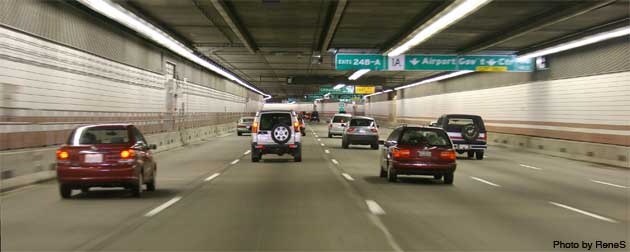From 1991 until 2006, the city of Boston experienced the largest and most expensive public works project in modern American history. The Central Artery/Tunnel Project, known as the Big Dig, was a multi-stage, multi-structure feat of engineering that completely changed the landscape of Boston. The project, however, was not without faults.
It is an example of what to do right and, at the same time, what not to do when it comes to large urban infrastructure projects. In the last segment of a five part series on infrastructure in the U.S., PBS NewsHour Senior Correspondent Ray Suarez reports with Blueprint America on the critical lessons learned from Boston‘s Big Dig.
[sorry, this video no longer available]
The Big Dig, in the end, submerged and expanded the 1.5 mile-long elevated Central Artery roadway, along a blight on the city’s North End; extended the Mass Pike (I-90) into the new Ted Williams Tunnel, creating direct access to Logan Airport and Boston’s North Shore; and built the Leonard P. Zakim Bunker Hill Bridge, a 10-lane cable-stayed bridge over the Charles River. All while keeping the city of Boston open for business.
Boston‘s traffic problems reached critical mass by the early 1990s, when the Big Dig construction began. The elevated Central Artery, conceived as a modern “highway in the sky” in the 1950s, was eventually choked with 190,000 cars per day and six-to-eight hour traffic jams. Cars were unable to travel to Logan Airport without passing over the congested Artery and through Boston‘s North End. The new Central Artery, in contrast, can carry up to 250,000 cars per day.
Submerging the old roadway has opened up surface roads, and more noticeably, given the city back over 300 acres of open space. Unlike the building process that created the old Central Artery, where over 20,000 residents were displaced and 1,000 buildings destroyed, the Big Dig’s “do-no-harm” approach to mitigating neighborhood, business and environmental concerns meant no homes or businesses paid the price for the construction.

Despite its overall successes, as both an infrastructure and city-building endeavor, the Big Dig is not without criticisms or failures. The project was originally budgeted at $2.6 billion dollars – its final costs were over $14.6 billion. It subjected the city’s residents to fifteen years of non-stop construction and a maze of detours. Lack of sufficient oversight kept tax payers in the dark about the true costs of the project for several years.
Additional transit projects, including Metro extensions promised as part of the Dig’s mitigation plans, remain largely unbuilt. And in 2006, a Boston resident was killed when a 26-ton section of the I-90 tunnel ceiling collapsed. That tragedy, and the engineering flaws responsible for it, resulted in a $450 million dollar lawsuit settlement between the state of Massachusetts, the Big Dig’s construction management company — Bechtel/Parsons Brinckerhoff — and other construction firms. A civil suit brought by the victim’s family against the construction contractors was just settled for $28 million.


